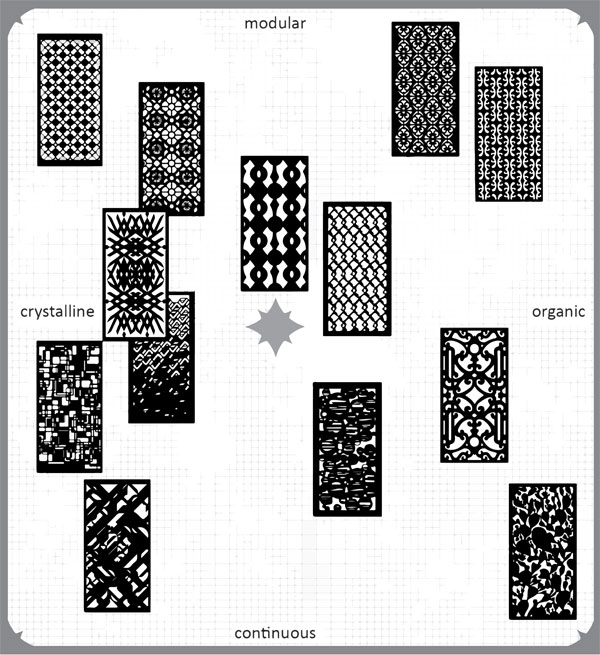Pattern Mapping for Lasting Design
Introducing Architectural Panels with Patterned Openings
Today, advancements in materials and manufacturing processes make it possible to machine a panel of aluminum, copper, or steel with a pattern quickly and cost-effectively. Referred to as an architectural panel with a patterned opening, this new option for bringing pattern into a space is created by cutting a pattern out of a solid material panel. The resulting panel not only contains a visually interesting pattern, but the open, cut-out nature of the pattern invites daylight and airflow into the experience as well. These panels, if designed for structural integrity, can be applied as overhead shade, architectural privacy screens, ornamental metalwork gates and railings, and even commercial building façade treatments.
The ultimate success of incorporating these architectural panels with patterned openings into a project space starts with selecting the right type of pattern for the installation. Selecting the right type of pattern requires that designers think beyond the aesthetic impact that a pattern can make and consider the functional performance of pattern in the visual space. That discussion begins with taking a closer look at patterns and exploring the concept of a pattern map.
Pattern Mapping
Pattern mapping is an exercise in establishing a baseline vernacular for architects, designers, artists, and building owners to discuss and compare patterns objectively in terms of how they will perform in a space. Created by public installation artist Uriah Bueller, the map evaluates a pattern on two key elements: structure and nature. Not only are these two characteristics discernible to some degree in every pattern, providing a solid foundation for comparing and contrasting, but these two elements materially affect how a person recognizes and responds to a pattern and should be considered when selecting a pattern that will help to achieve the overall objectives of the design.
Pattern Structure: Modular or Continuous
The structure of the pattern refers to the way in which the pattern is constructed. The pattern map evaluates construction across the continuum of modular to continuous. A modular pattern indicates that the pattern is constructed by the repetition of standardized, self-contained units. On the other end of the spectrum, a continuous pattern refers to a pattern that never seems to complete, but continues in one long unstopping structure.
Whether a pattern is modular or continuous affects how a person sees the pattern and how quickly the brain may try to see through the pattern to the items on the other side of it. As a regular repetition of a smaller design, the brain makes sense of a modular pattern more quickly than a continuous one and will attempt to look beyond a modular pattern more quickly. Continuous patterns seem to intrigue the brain for a longer period of time and the irregular, unpredictable shape does a better job of concealing whatever lies on the other side of the patterned panel.
Pattern Nature: Crystalline or Organic
The nature of a pattern refers to the temper of the elements in the pattern. Much like color is often evaluated as being warm or cool, the pattern map categorizes patterns as being crystalline or organic in nature. Crystalline patterns contain the same qualities often found in mineral structures. Straight lines and clearly defined angles are two elements that are commonly found in crystalline patterns. An organic pattern consists of softer forms such as curved, wavy lines that imitate the more complex appearance of items found in nature.
The nature of the pattern affects how the pattern makes people feel. Organic patterns are considered more warm and welcoming, while the more jagged crystalline patterns can make a more formal impression.
The Pattern Map
Here is an example of a pattern map. The y-axis charts the structure of the pattern, from modular to continuous, and the x-axis captures the specific nature of the pattern, ranging from crystalline to organic. The more continuous patterns toward the bottom of the map seem to be long, unstopping, and unrepeating designs, whereas the modular patterns at the top of the map are comprised of regular repetitions of smaller, self-contained design units. Evaluating the patterns from left to right, from crystalline to organic, the distinct straight lines and geometric angles give way to more complex curves.

Image courtesy of Parasoleil
Use a pattern map to identify where a pattern falls on the spectrum of continuous to modular and organic to crystalline to identify how it will perform in a space.









